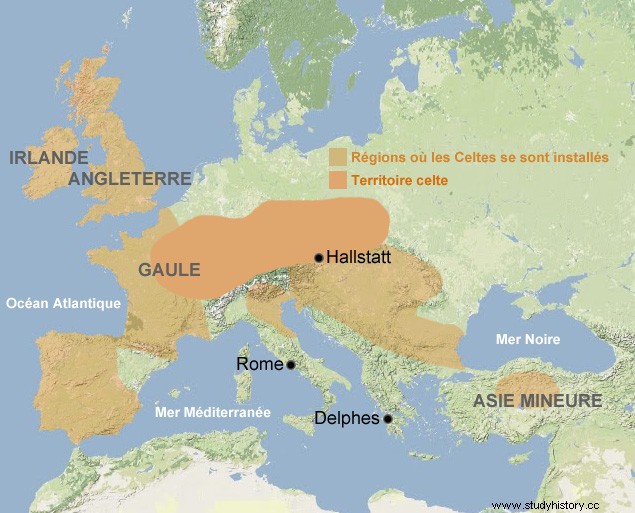
ABOUT 800 B.C. AD
Appearance of Celtic culture:
The Celtic people grows in the region of Hallstatt (today's Austria) and brings together many different tribes who share a similar language and way of life. Gradually, the Celts spread across much of Europe (including Gaul in present-day France) and settled in conquered lands.
Daily life of the Celts:
Where the Celts settle, they build farms and villages. Their houses are built of wood and stone with a thatched roof and they have only one room in which the family cooks, eats and sleeps. Tribes are mostly made up of fierce warriors and they often fight among themselves. At the entrance of the houses, the villagers hang the skull of their enemies you are. They erect fortresses on the heights to protect women, children and animals from enemy attacks. To celebrate their victories, the warriors organize great parties. Musician-poets, the bards, distract them by recounting the glorious deeds of Celtic heroes. The druids are the guardians of Celtic beliefs, but they are also judges and especially scholars . They transmit their knowledge orally, in the company of bards . Through music and songs, they are the guardians of Celtic memory.
Craftsmanship:
The Celts are skilled ironworkers . They make strong weapons, strong iron tools and create beautiful objects in bronze, silver and gold.
BETWEEN 750 and 450 BC. AD
Early Iron Age called Hallstatt Civilization:
iron metallurgy spreads in Gaul . Iron is reserved for weapons and bronze is still used for tableware, ornaments and statuettes. gold objects are also always found in large quantities.
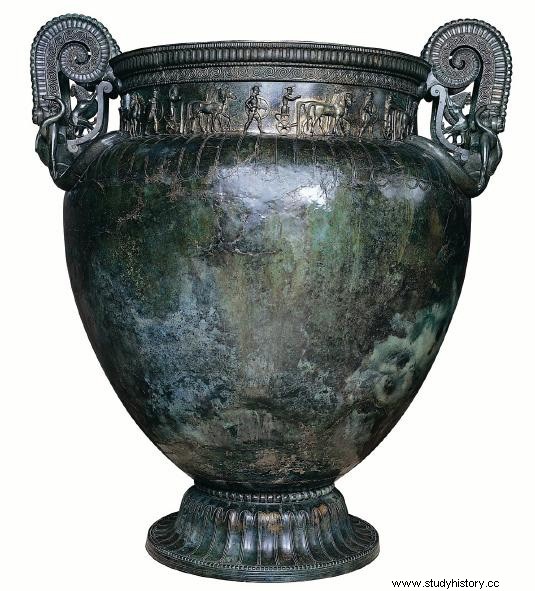
Vix's grave:
One of the most amazing and spectacular character of the Celtic civilization of Hallstatt lies in the digging of the princely tombs reserved for high personages. These are sometimes burials intended for women, which suggests that some played an important role in the Celtic community. The Tomb of Vix (Near Châtillon-sur-Seine, Côte d'Or, in present-day France) is one of the greatest French archaeological discoveries . It contained the body of a woman in her thirties, accompanied by her funeral ceremony chariot and above all the largest bronze vase known from antiquity:It is 1.64 meters high and weighs 208 kg.
ABOUT 600 B.C. AD
Foundation of Marseilles:
Phoceans (Greeks from Phocaea) founded a counter in a natural port, Massalia (Marseille) , which serves as a base for their trade in the western Mediterranean. The people of Marseille were not looking to colonize a settlement, but only to improve their trade with neighboring countries. After its foundation, the city of Marssalia developed rapidly and distributed its products in the hinterland. It retains its deeply Hellenic character:Stone ramparts, currency, written and spoken language, institutions, cults, etc.
Caption :Simos and Protis, two commanders of a Greek fleet, set out to find Nanus, the king of the Segobriges who was in the territory in which they planned to found a city. The day they arrived, the king was busy preparing for the wedding of his daughter Gyptis. According to national custom, he was preparing to give her in marriage to a son-in-law chosen by herself during a large banquet specially organized in this honor. As suitors were invited to the feast, Simos and Protis were also invited. The young girl, on her arrival, was asked by her father to offer water to the one she chose for husband. She turned to the two Greeks ignoring the other suitors and offered water to Protis. He thus became the son-in-law of King Nanus and received from him a site to found a city. Massalia was thus founded near the mouth of the Rhône, in an isolated gulf. This “legendary love at first sight” between Gyptis and Protis would be at the origin of the foundation of the city of Marseille. (Excerpt from the “Compendium of Philippine Histories” written by the Roman historian Justin).
TOWARDS 600-500 BC. AD
Foundation of Aléria, Agde, Antibes, Nice:
The southern coasts of France were frequented by the Etruscans, the Carthaginians and the Phocaeans. Phocaeans founded Alalia (Aleria in Corsica) while Massaliotes (inhabitants of Massalia) who left their city founded Agathé Tyché (Agde), Antipolis (Antibes) or even Nikaia (Nice).
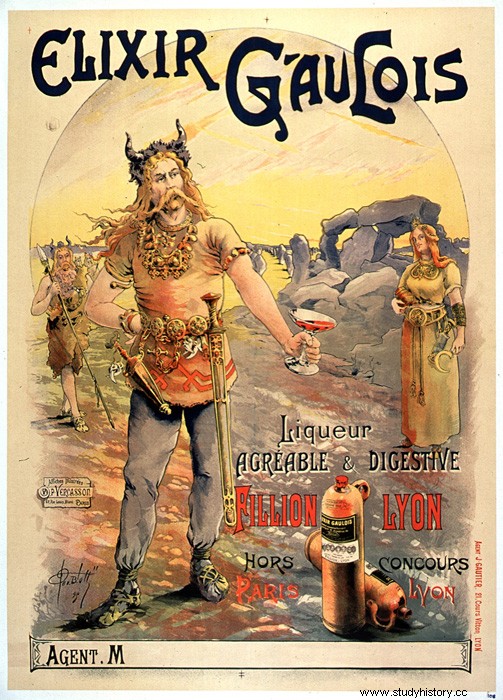
BETWEEN 450 and 50 AV. AD
Second Iron Age called La Tène civilization:
It is commonly accepted that Celtic civilization flourished in Gaul during this period. It was the Romans who then gave the name of “Gauls” to the inhabitants of this territory. We will also call them Gauls from now on to differentiate them from other civilizations.
Daily life of the Gauls:
The Gauls are divided into a number of peoples who each have a defined territory. Each people has a different name, the list of which was transmitted to us by Julius Caesar. The 2 most powerful Gallic peoples are the Arverni (Auvergne) and the Aedui (Burgundy). Each Gallic territory is governed by a king, but around 100 BC, it is mainly large families who meet in a kind of aristocratic assemblies. Thus each territory became an independent state with its own alliances, trade relations, etc. Gallic society asserts itself as rich and complex, open to others and to innovations. Contrary to the Hallstattian period, the wealth of the Gauls of La Tène was essentially based on agricultural work . The Gauls are also great craftsmen who excelled in the art of metallurgy, goldsmithing and enamelling, then unknown to the Greeks and Romans. They also excel in the art of war and sometimes rent their know-how to the Hellenistic kingdoms. The Gauls practice oral culture and their epics, poems, songs and beliefs are transmitted from generation to generation without the aid of writing. It is the bards, poets and druids who hold the Gallic collective memory.
Anecdote 1 :In Latin, gallus means both “rooster” and “Gauls” and this is how the rooster gradually became a sign of national recognition.
Anecdote 2 :Although reputed to be a “dirty” civilization, it was the Gauls who invented soap (in Latin Sapo):At the time, it was a kind of paste made from goat fat, grass and ash. The Gauls only used it as a hair lotion to strip and bleach their hair. (Bar soap as we know it today was brought from Syria during the Crusades.) To find out all about the saponification that currently makes soap, click here…
Gallic writing:
The Gauls know how to write and borrowed the alphabet from the Greeks. But they only write to transcribe commercial contracts, accounts, lists of names, property marks and a few epitaphs.
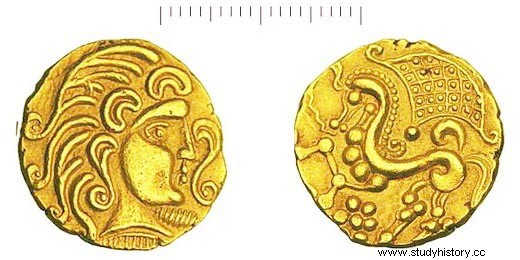
Gallic currency:
Coinage in Gaul appears around 300 – 200 BC. The Gauls first reproduced the model of Macedonian gold coins, then, around 200 BC, each people adopted its own style.
The appearance of the Gauls:
The descriptions given by ancient authors or the iconographic representations of the Gauls are somewhat caricatural. It seems that the Gauls take great care of their hair let them shine with soap. They also sport long mustaches and wear brightly colored or plaid pants. They wear jewels extremely varied which are real masterpieces. However, it seems that hair lengths, cuts, and colors vary across peoples and timelines. The same goes for the mustache and the beard, which gradually lose their importance.
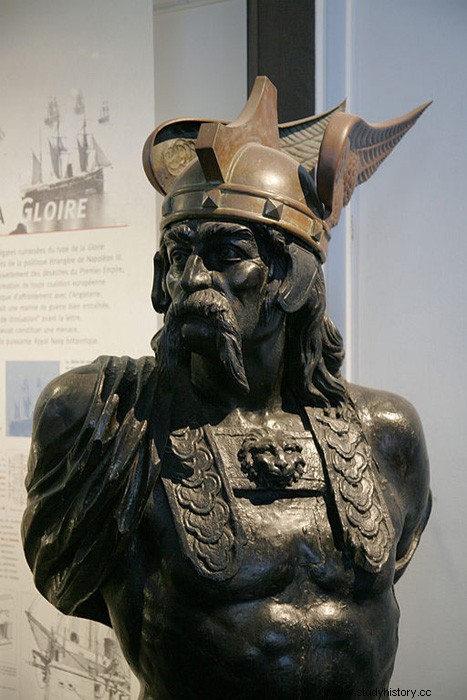
The Gallic pantheon:
The deities initially Celtic and venerated by the Gauls are poorly known and seem to vary from one region to another. Besides the god of war Teutatès , known to Asterix readers as Toutatis, the Gauls also revere the thunder god Taranis. They also believe that some of their gods inhabit streams, rocks, and trees. Thus, priests or druids throw precious objects into rivers and lakes as an offering to the gods. Sometimes they sacrifice animals or men.
ABOUT 390 B.C. AD
The Gauls sack Rome:
At that time the Romans were not yet the undisputed masters of the whole Mediterranean and Rome was still a modest city regularly attacked by its neighbors. Led by Brennnos (or Brennus in Latin), the chief of the Senons (people who gave their name to the city of Sens in Burgundy), the Gauls decided to attack and loot Rome.
Caption :Legend has it that the Romans, who were resisting the Gauls on the Capitoline Hill, were warned of a surprise attack by the din of geese who could not bear to be woken up in the middle of the night. This first assault repelled, the Gauls would have continued their siege. After a few months, as the Romans were running out of supplies, they agreed to negotiate. The Gauls agreed to withdraw in exchange for 1000 pounds of gold (more than 300 kg), but in order to increase the ransom, they placed false weights on the scale intended to weigh the pounds of gold. In front of the protest of the Romans, Brennos added still more to their dishonor by throwing his sword on the scales with panache, and by pronouncing these words which crossed the centuries “vae victis” (woe to the vanquished).
TOWARDS 279 B.C. AD
The Celts attack and loot the Greek temple of Delphi.
TOWARDS 278 B.C. AD
A Celtic tribe reaches Asia Minor (current Turkey):
They settled there and settled down.
TOWARDS 118 B.C. AD
“Free” or “hairy” Gaul:
We say "hairy" Gaul because of the thick forests that covered its territory at that time. This territory is divided into about sixty cities, that is to say peoples, and covers Belgian Gaul to the north, Celtic Gaul in the center and Aquitaine to the south-west.
BETWEEN 58 and 51 AV. AD
The Gallic Wars:
Driven out by the Germans , the Helvetians immigrated en masse to Gaul to settle near the ocean. The Aedui (Burgundy), who were directly threatened by this invasion, and who were allies of Rome, appealed to the Roman general Julius Caesar. This easily dissipates the Helvetians and drove out the Germans , but he does not intend to limit himself to a simple mission of assistance, and he clearly signifies his ambitions:Gaul will be for him what the East was for Pompey. Thus, quickly, practically all of the Gallic territory found itself under the domination of the Romans. Only a small village of indomitable Gauls resists the invader again and again... it is the village of Asterix of course! In reality, it was the Massif Central that again and again escaped foreign domination.
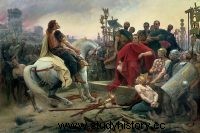
IN 52 B.C. AD
Gaul is defeated by Julius Caesar:
While Julius Caesar still continues his conquest of expansion, the Gauls continue to rebel. But in the absence of regrouping of the “cities”, they are unable to defend themselves against the Roman troops. It was then that the resistance united around a young man of 30:Vercingetorix . From one of the noblest families Arvernes (Auvergne), he knows Roman military techniques for having participated as a young man in the campaigns of Julius Caesar. He manages to influence the course of the war by employing the tactic of scorched earth :To deprive the Roman occupants of fodder and food and force them to evacuate the territory, he set fire to the surrounding towns and farms. Julius Caesar, then in Italy, returns to Gaul by forced marches. Refugee in Gergovie (near Clermont-Ferrand), Vercingetorix defeats the Romans who try to besiege it. Thanks to this victory, the young Avernus Vercingetorix is appointed commander-in-chief of the armies. The Gauls are finally gathered in front of the danger, but it is already too late... Julius Caesar has enlisted reinforcements of German horsemen to oppose the powerful cavalry of Vercingetorix . This was in difficulty near Dijon and the Gauls had to take refuge in the oppidum of Alésia . Despite their heroic resistance, they failed to break the encirclement of the Romans:The Roman legionnaires built in 5 weeks an unprecedented fortification system:They erected a line of defense 15 km in circumference to protect against exits from the besieged. This line includes 2 deep ditches, the first of which is filled with water. The 2 ditches are surmounted by a 4 meter rampart, punctuated by 24 meter wooden towers. A network of sharp stakes has been laid out in such a way as to hinder the possible advance of the enemies. Against external aggressors, another line of defense 21 km long was erected and oriented in the opposite direction. Starved, Vercingetorix and his troops engage in a last and terrible battle before laying down their arms. Vercingetorix goes to Julius Caesar who no longer has any trouble destroying the last centers of the Gallic rebellion. Julius Caesar's victory is complete:He brings new territory to Rome as well as a million Gallic slaves. Vercingetorix is brought back to Italy and ends up dying in a Roman prison , after being presented as a trophy during Julius Caesar's victory parade in Rome. The toll is heavy for the Gauls who are now subjects of Rome.
Celtic culture:
The Celts' way of life would only survive in Ireland and remote parts of Scotland, Wales and Britain.
Learn more about the Romans and Julius Caesar during antiquity.
Learn more about the ancient Greeks.
Useful link:
Youtube video, “It’s not rocket science” show: The Gauls
